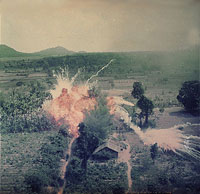Vietnam invited tourists into communist guerrilla caves bombed by US
More than three decades after the war ended, Laos has opened up to tourism a complex of caves which once sheltered communist guerrilla leaders from the most intense bombing campaign ever unleashed by the United States, an official statement said Tuesday.

The more than 480 caves, which once housed some 23,000 people, withstood a nine-year bombing campaign as the United States tried to destroy the nearby Ho Chi Minh Trail and stem the advance of North Vietnamese troops and their Pathet Lao allies.
Five of the caves, located near Viengxay in Houaphanh province, have recently been opened to the public and the site is slated for development with the help of international tourism experts, the Lao National Tourism Administration said.
"The Lao vision is to recreate the caves and tell the people's story," the release quoted Harsh Varma of the World Tourism Organization as saying. "Viengxay was a triumph of ingenuity and comradeship in the face of what many historians believe was the longest and most intensive aerial bombardment in world history."
Over 2 million tons of bombs were dropped on Laos over the nine years, more than the amount that fell on all of Europe during World War II.
The government also hopes that attracting tourists to one of the country's most remote and poorest areas will raise local incomes. Houaphanh province is the poorest in a country where 40 percent of the population survive on less than US$1 (76 euro cents) a day.
War tourism has proved a boon in neighboring Vietnam and Cambodia, where thousands of foreign and domestic visitors flock to such sites as the Khmer Rouge "Killing Fields" near Phnom Penh and the Cu Chi tunnels near Ho Chi Minh City.
The dramatic, limestone caves were used between 1964 and 1973 to house leaders and guerrillas of the Pathet Lao, who were fighting the U.S.-backed government in Vientiane which collapsed in 1975 with a victory by communists who still rule the country today.
The caves included a hospital staffed by Cuban doctors, shops, a school, printing house, bakery and theater, the AP says.
"At the height of the bombing it was impossible to imagine that tourists would one day wish to visit this place to learn about our experience," the release quoted Phonekeo Latsachanh, a Pathet Lao official who lived in the caves for nine years, as saying. "It's important that Lao people can now tell foreigners their story."
The government has asked the World Tourism Organization, the Netherlands Development Agency and the Asian Development Bank to develop the location as a tourist destination. But the Lao tourism agency acknowledges that there is more work that needs to be done: the area is hard to access and local facilities are few.
Viengxay currently offers just one simple hotel with 16 rooms and three basic guest houses with a combined total of 26 rooms.
With an average of only 10 visitors a day to the five open caves, Siphan Vangduayang, director of the Memorial Cave Office in Viengxay, said: "We need more visitors. We had over 20,000 people living here all those years ago. We have room."
Subscribe to Pravda.Ru Telegram channel, Facebook, RSS!




